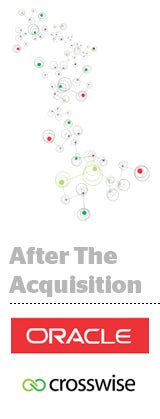 Last year, Oracle had deals going with a number of different cross-device players, including Drawbridge, pre-Telenor Tapad and Crosswise.
Last year, Oracle had deals going with a number of different cross-device players, including Drawbridge, pre-Telenor Tapad and Crosswise.
In April, Oracle decided to make one of those companies its own, snapping up Crosswise for its data cloud for a reported $50 million.
Although Tapad and Drawbridge still power Oracle Data Cloud products, there came a point when it just made more sense to buy some cross-device tech of its own, said John Dempsey, senior director of mobile for the Oracle Data Cloud.
“Basically, Crosswise lets us point really good data science against all of our data to increase the accuracy of the output,” said Dempsey, who noted that Crosswise is sold as a sort of independent linkage service that doesn’t include data pulled from its other cross-device partners.
There are three main things you need to build a probabilistic cross-device solution – observation data (the signals coming in from and around devices); a truth set (to test the accuracy of the connections); and an algorithm (to train the observation data against the truth set).
Oracle already had the first two via first- and third-party data from BlueKai, offline sales data from Datalogix and social signals from AddThis, which Oracle acquired earlier this year.
“We see 15 million websites and 2 billion devices on a regular basis globally,” Dempsey said.
The addition of Crosswise is about building out the connections, which is now a big part of Steve Glantz’s job. The Crosswise co-founder and former CEO is now leading business development for the Oracle ID Graph.
The Crosswise technology is in the process of being integrated into the Oracle Data Cloud, a project Glantz said is already underway and should be complete in the relatively near future.
The process also shouldn’t be too painful because the two companies are fairly simpatico, Dempsey said. Part of what made Crosswise attractive in the first place is the fact that it was a pure data company with no media business. Oracle wasn’t in the market for a DSP.
“They didn’t want a media business,” Glantz said. “But, of course, money isn’t really an issue for Oracle, so if there was another company out there they thought had better data science and it came with a media business, that wouldn’t have stopped them from buying it.”
Ultimately, Crosswise ID Graph technology will be assimilated into all Oracle Data Cloud products, including BlueKai and Datalogix audiences.
Oracle is maximizing cross-device scale through probabilistic matching, Dempsey said, which is cheaper than paying an external cross-device specialist or a publisher for the privilege.
“We’ve seen that probabilistic is core to any solution you roll out to achieve the scale necessary to get across all devices,” said Dempsey. “But it’s also more cost-efficient because you’re not spending a tremendous amount of money directly with publishers to make connections between email an in-app or app and cookies.”
The notion that probabilistic matching is inferior to deterministic is a far too simplistic way to think about the cross-device question, Glantz said.
“A lot of deterministic data is actually garbage,” he said. “If my kid logs in to a game on my phone with their email address, suddenly my phone is matched to my kid’s laptop. It’s ‘true’ and there’s a connection, but those two devices don’t belong to the same person.”
There’s a lot of nuance that goes into making these matches correctly, which is why Dempsey is highly dubious of Nielsen’s attempt to verify cross-device identity graphs. In 2014, Tapad had its graph verified at 91.2% accuracy, and Drawbridge followed suit in 2015, claiming 97.3% accuracy as verified by Nielsen.
“These numbers have done a disservice by making people think that there’s one level of accuracy and that accuracy can be that high for an entire graph – it’s ridiculous,” Dempsey said. “We view accuracy as a sort of sliding scale. But when it’s done right, you can build up a significant pool of devices that have the same accuracy that a deterministic data set can have.”
Oracle also plans to use Crosswise to facilitate international expansion to new markets, including APAC, Europe and Latin America. With the Crosswise algorithm, it’s just a matter of finding a local truth set to train against before a new graph is up to speed, Dempsey said.
And while Facebook and Google are waiting in the wings to eat everyone’s lunch, Oracle views them as partners rather than the competition, Dempsey said.
Facebook in particular is “great at mapping devices to identity, but they only operate in their own network, which is good if you’re buying on Facebook, but not so good if you also run through a DSP,” he said. “And that’s where we come in. We can tap into the walled gardens.”
Crosswise’s 18-person team is staying in the company’s home base of Tel Aviv. Glantz is actively hiring with an eye on expanding the headcount by as much as three times in the near term.













